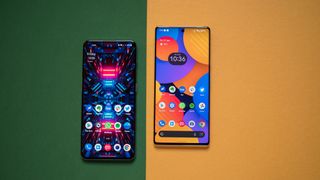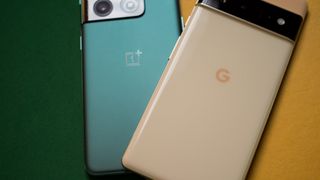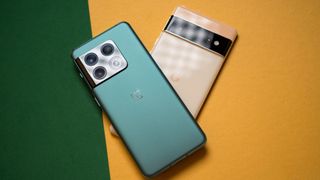OnePlus 10 Pro vs. Google Pixel 6 Pro
OnePlus's 2022 flagship is a worthy rival to the Pixel 6 Pro.

Fast and fluid
The OnePlus 10 Pro is a good option to consider: it has the latest Qualcomm hardware along with a 120Hz AMOLED screen that's ideal for gaming and streaming videos. The 48MP camera at the back is tuned by Hasselblad, and it takes stellar photos in any scenario. You also get 80W wired and 50W wireless charging, as well as three Android OS updates. The software isn't as lightweight as it used to be, but you don't get any bloatware. The biggest issue is that the wide-angle lens isn't anywhere as good as other devices in this category.
For
- Sublime 120Hz AMOLED panel
- Latest internals
- Good 48MP camera at the back
- Ultra-fast 80W wired / 50W wireless charging
- Will receive three Android OS updates
- Bloat-free software
Against
- No IP68 rating
- Wide-angle lens not as good as last year
- Slow software updates

Best of Google
With the Pixel 6 Pro, Google has finally delivered a flagship that can hold its own against its rivals. The phone has a bold design with a two-tone finish and a large camera bar that looks striking, and the 120Hz AMOLED screen has excellent colors. The custom Tensor platform is on par with Qualcomm's latest offerings, and of course, you're getting one of the best camera packages you'll find on Android here. It doesn't miss out on any of the extras either, and you get all-day battery life along with clean software and fast updates.
For
- Gorgeous design
- Smooth 120Hz AMOLED screen
- Outstanding cameras
- Powerful hardware
- Great battery life
- Clean software with three Android OS updates
- IP68 water resistance / wireless charging
Against
- Only available in select global markets
- No bundled charger
- Fingerprint sensor is woefully slow
OnePlus shifted focus to the flagship category three years ago with the introduction of the 7 Pro, but it wasn't until the 9 Pro that it was able to deliver a good all-round package that was able to challenge the likes of Samsung, Xiaomi, and Google. The 10 Pro continues in that vein, retaining a lot of the same features that made its predecessor a great overall option.
Google's journey is similar — the brand has been making flagships for six years now, and while Pixels have dominated on the camera front, each generation had its share of hardware drawbacks and couldn't quite measure up to its rivals. That's changing with the Pixel 6 Pro, so let's take a look at how the phone fares against the OnePlus 10 Pro.
OnePlus 10 Pro vs. Google Pixel 6 Pro: Design and screen
Why you can trust Android Central

Both OnePlus and Google went with aggressive designs this generation, with the OnePlus 10 Pro fielding a huge rectangular camera cutout at the back that extends seamlessly to the mid-frame. You'll also find large rings encircling each camera module, and there's a Hasselblad logo to good effect. The housing looks good on the Emerald Forest variant that I'm using, and if you want a more subdued finish, there's a Volcanic Black option available.
The Pixel 6 Pro has a better design, but it is larger and heavier, making it that much more unwieldy to use.
The Pixel 6 Pro, meanwhile, has a two-tone finish that looks really good in the Sorta Sunny hue, and the large camera bar that runs across the width of the device makes it look striking. As the camera bar covers the entire width, the phone doesn't wobble when laid flat on a table, unlike the 10 Pro.
Both devices have flowing curves at the front and back, but the curvature isn't as extreme on the Pixel 6 Pro. That said, the phone is taller by 0.9mm, wider by 2mm, and bulkier by 0.3mm over the 10 Pro, and that is immediately noticeable. It is also heavier by 9g, and the added width in particular makes it not as comfortable to hold and use as the 10 Pro. That said, Google did a good job with the weight distribution, and even with that large camera housing at the back, the Pixel 6 Pro doesn't feel top-heavy.






You won't find a 3.5mm jack or microSD slot on either device, but the 10 Pro has a dual-SIM as standard outside North America. A minor irritant on the Pixel 6 Pro is the positioning of the buttons: most phones have the power button beneath the volume rocker, but for whatever reason, Google put the power button above the volume buttons, so for the first week of using the phone, I routinely pressed the volume down key to wake the device.
This isn't an issue on the 10 Pro; the power button is on the right, and the volume rocker is to the left. You'll also find the nifty alert slider, and it continues to be a good hardware differentiator for OnePlus that lets you easily switch between silent, vibrate, and call modes.
Both phones have an aluminum mid-frame sandwiched between panes of glass. My 10 Pro took a few tumbles and came away without any issues, and the Pixel 6 Pro should be just that little bit more resilient thanks to Gorilla Glass Victus at the front and back — thankfully, I didn't get a chance to test that out just yet. The 10 Pro, meanwhile, has Gorilla Glass Victus at the front and Gorilla Glass 5 at the back.

Switching over to the screen, the 10 Pro comes with a 6.7-inch QHD+ (3216 x 1440) AMOLED panel with 120Hz refresh rate, and you get HDR10+, a lot of customization, and excellent colors and contrast levels.
The Pixel 6 Pro isn't far behind in this area, offering a 6.71-inch QHD+ 3120 x 1440) AMOLED panel with the same 120Hz refresh, HDR10+, and fabulous color vibrancy. You won't find as many options for tweaking the screen to your liking on the Pixel 6 Pro, but it does a great job out of the box, and there isn't an outright winner here — the panel quality is on par with the best Android phones.
Talking about similarities, both phones have stereo sound, and they get sufficiently loud that the onboard audio is serviceable for gaming and streaming the occasional video.
OnePlus 10 Pro vs. Google Pixel 6 Pro: Hardware

As for the internal hardware, the OnePlus 10 Pro comes with the latest Qualcomm silicon, just like the best Android phones of 2022. The 4nm Snapdragon 8 Gen 1 delivers incredible performance for just about any use case, and you won't see any slowdowns or lag even in demanding games.
The Pixel 6 Pro is a smidgen less powerful than the 10 Pro, but it comes with better 5G connectivity and the latest Wi-Fi 6 standard.
The Pixel 6 Pro, meanwhile, is the first phone with Google's custom Tensor platform. Google partnered with Samsung over the manufacture and design of the chipset, and as a result it is very identical to last year's Exynos 2100. But the 5nm part has a few key differences: it features two Cortex X1 cores for high-intensive tasks, joined by two A76 and four A55 cores.
For context, the Exynos-based version of the S21 Ultra has one X1 core alongside three A78 and four A55 cores, and it has a Mali-G78 with 14 shader cores. The Tensor has the same Mali design, but you get 20 shader cores instead. The Pixel 6 Pro isn't quite as powerful as Qualcomm's latest silicon, but it isn't far behind, and for its part, Google did a good job adding unique features to Tensor — like a custom security sub-system and faster AI engine for on-device AI and ML tasks.

I switched to the Pixel 6 Pro after using the OnePlus 10 Pro for two months, and I didn't see any difference in day-to-day fluidity. Google's Tensor platform may not be on par with Qualcomm in synthetic tests, but you won't notice any difference between the two devices in real-world use — the Pixel 6 Pro also does a great job with demanding games and multitasking.
Both phones also sport good haptics engines, delivering granular feedback. The 10 Pro is more customizable in this area, giving you the ability to fine-tune vibration intensity and pattern. That said, the Pixel 6 Pro has a distinct edge when it comes to connectivity, with the North American model featuring Sub-6 and mmWave 5G connectivity as standard — the 10 Pro is limited to Sub-6 bands, and the unlocked model doesn't work on all carriers. The Pixel 6 Pro also has Wi-Fi 6e, with the 10 Pro limited to Wi-Fi 6. Both devices have Bluetooth 5.2, NFC, and the usual suite of AptX HD codecs.
The biggest downside for the Pixel 6 Pro in this area is the fingerprint sensor. Google went with an optical module like most manufacturers, but it just isn't on the same level as other mid-range phones, much less flagships. It takes far too long to authenticate, it has a high error rate, and it just makes using the device that much more annoying. It got to a point where I set up Smart Lock to have the phone unlocked whenever I'm home.

You'll find a 5000mAh battery under the hood on both devices, and while the Pixel 6 Pro has a single battery that charges at up to 30W, the 10 Pro has dual 2500mAh cells that can individually charge at 40W simultaneously. That allows the phone to maximize its 80W charging potential, with the device taking just over 30 minutes to fully charge the battery.
The Pixel 6 Pro takes considerably longer, and you don't get a charger in the box. It's a similar story for wireless charging — the Pixel 6 Pro goes up to 23W, while the 10 Pro can hit 50W wirelessly.
As for battery life itself, both devices do a good job lasting all day, and there's no battery anxiety here. I routinely found that I got a day and a half worth of power out of both devices, and even with heavy use, you shouldn't have any issues getting to the end of the day.
OnePlus 10 Pro vs. Google Pixel 6 Pro: Cameras

The main reason for picking up a high-end phone in 2022 is the cameras. With mid-range phones featuring reliable hardware and all the extras that were previously limited to flagships, there isn't as big a gulf between $1,000 phones and devices that cost half as much.
But if you want the latest camera tech and versatile lenses, you'll need a flagship, and in this area, the Pixel 6 Pro has a lot to offer. The phone has a 50MP f/1.9 lens with OIS that's paired with a 12MP wide-angle lens with 114-degree field of view and a 48MP zoom module with 4x optical zoom and OIS.
For its part, OnePlus didn't tweak the hardware too much over the 9 Pro, with the 10 Pro featuring the same Sony IMX789 as last year and the same 8MP zoom lens. There's a new 50MP wide-angle module this time around, and you'll find the same Hasselblad-focused changes to the UI as well as a few exclusive filters.
Pixels have always stood out for their cameras, and the Pixel 6 Pro is no different. The phone takes phenomenal photos in daylight and demanding situations, and like its predecessors, it unerringly manages to take a great shot the first time. The 10 Pro holds up in most situations, but even with the Hasselblad camera tuning, it doesn't quite deliver the same caliber of photos as Google.
The Pixel 6 Pro dominates in low-light situations, delivering photos with plenty of detail without blowing highlights. The resultant shots have Google's signature look with high contrast levels, and they're ideal for sharing on social media. The 10 Pro does a good job as well, but it struggles with color balance and misses out on finer details. For instance, look at the exhaust fan at the back; you can see the individual LEDs and the mount in the shot taken with the Pixel 6 Pro, but these details merge together in the 10 Pro.
Google also does a better job with exposure control. In this photo, the Pixel 6 Pro shows accurate colors and doesn't overexpose the photo, unlike the 10 Pro.
The 10 Pro does a fantastic job with this photo, with the red hue shining through the shot. But the Pixel 6 Pro does a better job with the details — like the grooves on the ear pads — and the added contrast makes the photo that much more vibrant.
If you take a lot of portrait shots, there's no better phone than the Pixel 6 Pro. Pixels have always taken incredible portraits, and where Google beats its rivals is at taking images of inanimate objects.
All things considered, the OnePlus 10 Pro does a good job in this area, but it lacks the versatility and the finesse that Google has to offer. The wide-angle lens on the 10 Pro is lackluster when seen next to its rivals, and the zoom lens is similarly not as good as what you'll find on the 6 Pro. The software tuning is much better this time, and you'll find a few Hasselblad extras that let you take dynamic shots.
But at the end of the day, the Pixel 6 Pro is the outright winner here. Google has once again delivered a strong camera package, with the phone able to deliver outstanding photos in just about any situation.
OnePlus 10 Pro vs. Google Pixel 6 Pro: Software

Google debuted the Material You design language with Android 12, with the interface sporting bright colors and better customizability. The design changes are polarizing, but I like the direction Google is taking with Material You — Android needs to be fun and accessible, and that's what Google is doing.
Both phones will get three platform updates, but if you want timely updates, the Pixel 6 Pro is the one to get.
OxygenOS also underwent a drastic design change last year following the integration with ColorOS, and as such, OxygenOS 12 looks very different to earlier versions of the skin. There are a lot of new features on offer, but if you've used OxygenOS for its clean UI and fluidity, you won't like many of the changes in OxygenOS 12.
I prefer Google's take on Android 12, and while OxygenOS 12 has plenty of customizability, it doesn't feel very cohesive.
And as for updates, both phones will get three platform updates, but I'm not confident in OnePlus's abilities to roll out updates on time. The manufacturer has done a poor job delivering the stable Android 12 update to its phones, and I don't see that changing in the near future. Google had its share of bug-filled updates, but for its part, it does a good job fixing those issues. And there's no denying that Pixels are first in line to get the latest Android releases.
OnePlus 10 Pro vs. Google Pixel 6 Pro: It's an easy choice

The OnePlus 10 Pro gets a lot right in terms of the hardware; it is fluid in daily use, and it is one of the fastest phones around. The software isn't as cohesive as I'd like, but for what it's worth, you won't find any bloatware here, and with the latest OxygenOS 12.1 build, there aren't many bugs. Combine that with blazing-fast wired and wireless charging, and you have a good all-round package.
If you're in a country where Google sells the Pixel 6 Pro, it is the obvious choice.
That said, the Pixel 6 Pro is the better choice of the two. Google's flagship has a gorgeous design, and the Tensor platform holds its own against Qualcomm. The phone will be the first to get the latest platform updates, so that's something that you care about, you should pick up the Pixel.
But the biggest reason to do so would be the cameras; the Pixel 6 Pro continues to further Google's heritage of delivering fantastic cameras, and in addition to all the software wizardry on offer, you get a good array of sensors that are versatile.
The 10 Pro is found lacking in this area, and although the Hasselblad integration allows the device to take good photos, you miss out on a good wide-angle lens.
Having used both of these devices extensively over the last three months, I'm inclined toward the Pixel 6 Pro. Both phones retail for $899 — so cost isn't an issue here — and you just get a lot more value for your money with the Pixel 6 Pro.

Fast and fluid
The OnePlus 10 Pro delivers the latest hardware along with a bold design, ultra-fast charging, great camera, and bloat-free software. This is one of the fastest phones you'll find today, and it is good to hold and use. However, the camera isn't quite as good as what you get on the Pixel 6 Pro, and you miss out on a few features.

Best of Google
The Pixel 6 Pro is Google's strongest showing yet, with the device featuring one of the best cameras of any phone today. Google's custom silicon is able to hold its own against its rivals, and you get a unique two-tone design that stands out along with the latest software features and fast updates.
Be an expert in 5 minutes
Get the latest news from Android Central, your trusted companion in the world of Android

Harish Jonnalagadda is a Senior Editor overseeing Asia at Android Central. He leads the site's coverage of Chinese phone brands, contributing to reviews, features, and buying guides. He also writes about storage servers, audio products, and the semiconductor industry. Contact him on Twitter at @chunkynerd.